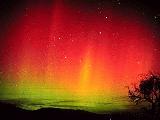
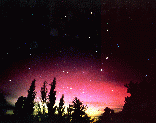
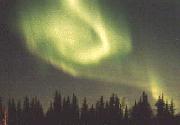
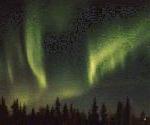
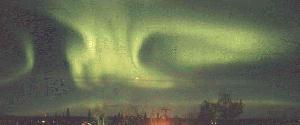





As seen from the Space Shuttle:
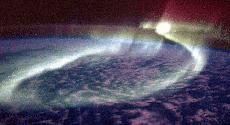
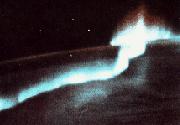
Internet Resources
The Aurora Forecast Page is a good launch pad into auroral cyberspace. Check out the FAQ.
Aurora's Northern Lights site by Jan Curtis with links to photos and other stuff
University of Oulu's Aurora Page
Another Finnish website with articles on myth, history, etc.
Space Environment Center's pdf file on Aurora
Windows to the Universe Aurora page
Michigan Tech University's Aurora Links Page
UCAR's (University Corporation for Atmospheric Research) Physics of the Aurora webcast
A brief YouTube video from the University of Oslo
An "old-fashioned" source (a book): Majestic Lights by Robert Eather; on-line preview
PBS Nova program At the Edge of Space airing on Nov 20, 2013 (last eight minutes about aurora)
MOST RECENT MAPS of the position and extent of the northern and southern auroral ovals
Historical outline of Auroral Imaging
| 20,000 B.C. | earliest depictions(?): Serpertine meanders (macaronis) in cave drawings by Cro-Magnon |
| 1575 | First published scientific illustration by Cornelius Gemma |
| 1885 | Sophus Tromholt attempts photography; gets a blurry blob after 8 minute exposure |
| 1892 | Martin Brendel obtains first useful (B&W) photographs |
| 1910-43 | Carl Störmer takes thousands of photos |
| 1913 | Störmer records movie (4 seconds per frame) |
| 1940 | Störmer begins unsuccessful attempts at color photography |
| 1951 | Gartlein and Petrie present color photos at Auroral Conference in London, Canada |
| June 1953 | Life Magazine publishes color photos |
| 1968 | Imaging with orbiting satellites begins |
| 1970's | Color movies become practical with availability of high-speed color film |
| 1980's | Significant improvements due to low light television technology |
International Brightness Coefficient
| Coefficient | Appearance | Equivalent to: | Brightness |
| IBC0 | subvisual | < 1 kRa | |
| IBC1 | appears white | Milky Way | 1 kRa |
| IBC2 | onset of color perception | Thin moonlit cirrus | 10 kRa |
| IBC3 | bright stars don't shine through | Moonlit cumulus | 100 kRa |
| IBC4 | casts shadows | Full moonlight | 1000 kRa |
| ca. 2600 BC | Possibly first written description in Bamboo Album of Chronology (Chu-Shu-Chi-Nien) |
| 8th c. BC | Hesiod in Theogony describes flaming heavens, fiery sky dragons |
| 687 BC | First aurora listed in Chinese historical catalogs (through to the 10th c. AD) |
| ca. 460 BC | Mention in histories of Livy and Dionysius (Roman) |
| ca. 340 BC | Infiltration during night of the army of Philip of Macedonia into the city of Byzantium reputably foiled by light from aurora |
| 37 AD | Tiberius mistakenly sends Roman army to put out fire seen on the horizon |
| 555 | Earliest mention in England by Mathew of Westminster |
| 919 | Earliest event known in written Russian record |
| 1100's | regular observers (Mathieu of Edesse - Middle East; Vysehrad - Prague; Gervasius - England) |
| 1111 | Victory of outnumbered Russian army over Polovtsy attributed to appearance of aurora behind the Russians
[The dance, Russian lyrics (transliterated), promo, English subtitles (with a little rap), Bennett] |
| 1192 | Great Aurora of 1192 |
| 1200-1500 | few recorded auroral sightings due to warfare (e.g. Mongol threat, Crusades), plague (Black Death), religious dogma (generally a bad time had by all) |
| 1400-1500 | Spörer Minimum (little solar activity) |
| 1500's | Renewed auroral activity reported in Europe |
| 1643 | First sighting with known written report in North America (by John Winthrop, Governor of Massachusetts) |
| 1645-1715 | Maunder Minimum (little solar activity) |
| 3/17/1716 | Great Aurora over Europe |
| 1719 | Bright aurora over New England and China |
| 9/2/1859 | Brightest aurora ever reliably reported occurs day after Carrington discovers solar flare |
Historical Auroras
List of some great aurora and recent bright displays
another list with links to contemporary newspaper reports.
Aurora as Omen
Some events that have been associated with the appearance of an aurora:
| 44 BC | The assassination of Julius Caesar |
| 1st c. AD | Pliny the Elder describes earlier aurorae as "presage of woe" |
| 451 | The defeat of Attila at Catalaunic Fields |
| 566 | The invasion of Italy by Lombards in 568; aurora receives moniker "acies igneae" (battle lines of fire) |
| 566 | The birth of Mohammed in 570 |
| 793 | Anglo-Saxon Chronicles notes "this year dire forewarnings came over the land" |
| 1170 | The blood of Thomas à Becket rising to heaven |
| 1177 | Temujin (Genghis Khan) took as sign that he would unite Mongols and conquer the world |
| Jan 15,1192 | Famine of 1197 in Europe |
| Nov 14,1574 | Earthquake on Feb 26,1575 |
| March 6,1716 | The execution of Lord Derwentwater (Jacobite uprising) NORTHERN LIGHTS, The Story of Lord Derwentwater |
| Oct 8,1728 | Earthquakes in Sicily and England |
| Jan. 25, 1938 | World War II |
Aurora in Legend and Folklore
See these brief on-line descriptions:
Auroral Folklore
Various Beliefs
Aurora in Eskimo Legend
Native American Legend and Folklore
Possible source of Greek myth of Mount Olympus as home of the Gods
Probably only instance where the aurora is actually a deity (god of birth) is among the Chuvash, an ethnic group with a republic in the Russian Federation
Possible Biblical References
The visible aurora extends vertically along magnetic field lines often for tens of miles and horizontally east-west for hundreds of miles, but the auroral feature is usually only 100 yards or so thick (north-south). The shape or form of an aurora therefore is dependent on the perspective of the observer.
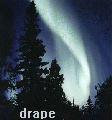

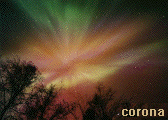
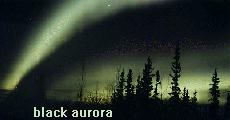
Auroral Types:
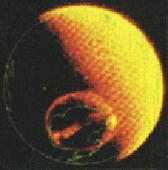
A crude analogy
like a television:
Another crude analogy
like a toaster:
The following excerpt is from The Auroral Particles and Imagery Group at The Johns Hopkins University Applied Physics Laboratory (JHU/APL)
The Earth wears a halo around each magnetic pole. The halo is visible to the naked eye (well, at least to an astronaut above the poles) near winter solstice, and can be observed any time in ultraviolet (uv). This ring, called the auroral oval, divides the Earth's magnetic field lines into two types:
At the interface between open and closed field lines dramatic plasma physics processes occur, including the ring of light forming the auroral oval.
Auroral Oval versus Auroral Zone
The Auroral Oval: the instantaneous position of luminosity below which the Earth rotates. Typically around 67 degrees geomagnetic latitude around midnight and moving to 78 degrees geomagnetic latitude at midday. The picture below shows the auroral oval in winter approaching midnight in Albany, NY
The Auroral Zone: the position of maximum probability of observing auroral luminosity. Viewing conditions are best around midnight and the aurora also tends to be brighter in this section of the oval. Consequently the highest probability of viewing aurora occurs around the geomagnetic latitude of 67 degrees
Note that the Auroral Zone passes through central Alaska, but in the picture below taken just after sunset in Alaska, the Auroral Oval lies to the north. The aurora may be visible at this latitude only during winter; at other times of the year the aurora is not usually visible here because of daylight. The Auroral Oval will pass over central Alaska later in the evening.
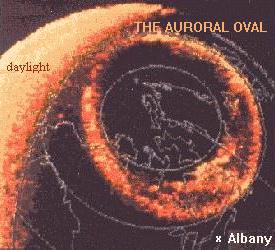
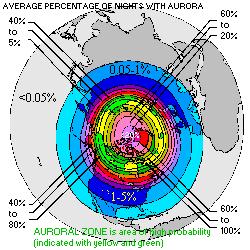
Other notes:
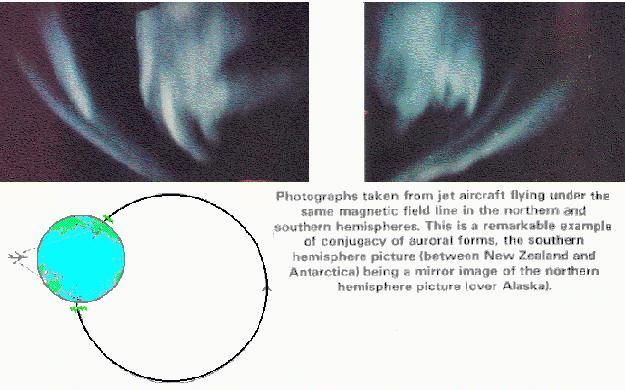
OTHER AURORAL PHENOMENA (non-luminous)
| 5th c. BC | Hippocrates suggests aurora is caused by reflected sunlight |
| 332 BC | Aristotle in Meteorologica suggests flammable vapors produce "chasmata" |
| 585 AD | Gregory of Tours describes aurorae as natural phenomena (not supernatural) |
| 1527 | Peter Creutzer produces first printed description |
| 1563 | William Fulke treatise claims aurorae are burning vapors |
| 1575 | Cornelius Gemma publishes first scientific illustration |
| 1607 | Johannes Kepler describes aurora |
| ca. 1620 | Galileo Galilei or Pierre Gassendi coin name "aurora borealis" |
| ca. 1620 | René Descartes proposes sunlight scattered from ice crystals in clouds |
| 1719 | Edmund Halley proposes "magnetic effluvia" |
| 1728 | W. Derham suggests venting of vapors and association with earthquakes |
| 1733 | Jean Jacques d'Ortous de Mairan publishes first textbook devoted to aurora; proposes mingling of Earth and solar atmospheres/zodiacal light; suggests sunspot correlation, existence of southern aurora |
| 1741 | Anders Celsius and Olof Hiorter note coincidence of magnetic storms and aurorae |
| 1746 | Leonhard Euler proposes escaping particles at the poles |
| 1750 | Mairan obtains report of 1745 southern aurora (from Capt. Don Ulloa) |
| 1752 | William Watson invents discharge tube; leads to electrical discharge theories of aurora by Mikhail Lomonosov and Ben Franklin among others |
| 1777 | J.C. Wilcke notes corona aurora converges on local magnetic field line |
| 1790 | Henry Cavendish measures height successfully, 50 - 70 miles high |
| 1792 | John Dalton proposes luminous magnetic (iron) particles |
| 1806 | Alexander von Humboldt notes coincidence of auroral display with magnetic storm |
| 1815 | Alessandro Volta proposes condensing electrical fluids |
| 1817 | Jean Batiste Biot proves aurora is self luminous (not reflected sunlight) (more on history and physics of optical polarization) |
| 1819-47 | John Franklin arctic exploration and disappearance. One ship found in 2014 |
| 1822 | Franklin notes decrease in auroral frequency toward pole |
| 1835 | Denison Olmstead proposes cosmic origin (ferric cosmic dust clouds) |
| 1854 | Auguste de la Rive publishes theory Demonstration apparatus at the Mus�e d'histoire des sciences, Gen�ve, Suisse |
| Sep 1, 1859 | Carrington discovers solar flare; brilliant aurora occurs evening of the 2nd |
| 1860 | Elias Loomis maps northern auroral zone |
| 1868 | Anders Angstrom finds auroral green line and later other lines |
| 1873 | Loomis shows frequency of mid-latitude auroral displays correlates with sunspot cycle |
| 1878 | William Crookes invents cathode ray tube and discovers rays are deflected by magnetic fields |
| 1878 | Henri Bequerel proposes aurora caused by hydrogen from Sun (discovered natural radioactivity 1896; Nobel Prize 1903) (See history outline of the solar wind) |
| 1880 | Eugen Goldstein proposes aurora caused by cathode rays from Sun |
| 1881-82 | First Polar Year |
| 1881 | Hermann Fritz improves auroral map, solar cycle connection |
| 1885 | Sophus Tromholt notes change of position of aurora with time of day |
| 1897 | J. J. Thomson discovers electrons as particles in cathode rays (Nobel Prize 1906) |
| 1903 | Kristian Birkeland infers existence of large currents associated with aurora (auroral electrojets) |
| 1900-13 | Birkeland conducts demonstrations with physical model terrella |
| 1911 | Alfred Wegener proposes green line is due to "geocoronium" |
| 1911-43 | Carl Störmer makes extensive auroral observations |
| 1912-13 | Lars Vegard identifies auroral nitrogen bands (blue, red) |
| 1915 | William Ramsay proposes green line is due to krypton (Nobel Prize in 1904 for discovery in air of argon, helium, krypton, neon and xenon in the 1890's) |
| 1923 | Vegard suggests green line is due to solid nitrogen crystals |
| 1928 | John McLennan identifies green line to be due to atomic oxygen |
| 1930 | Störmer classifies auroral forms |
| 1930-31 | Second Polar Year |
| 1937 | Vegard suggests atomic oxygen is excited by energy tranfer with molecular nitrogen |
| 1939 | Southern auroral zone is mapped |
| 1939 | Vegard identifies red & blue hydrogen lines |
| 1948 | Vegard detects fast protons from Doppler shift of hydrogen lines |
| 1954 | Rockets detect fast electrons as source of aurora |
| 1957-58 | Int'l Geophysical Year - numerous amateur reports; all-sky cameras |
| 1957 | John Winckler discovers auroral X-rays |
| 1963 | Yasha Feldstein maps auroral oval |
| 1964 | Syun Akasofu connects auroral bursts to magnetospheric substorms |
| 1968 | Conjugacy (mirroring) of northern and southern aurorae is shown |
| 1972 | ISIS-2 satellite discovers diffuse aurora |
| 1974 | Triad satellite provides evidence for "Birkeland Curents" |
| 1981 | Dynamics Explorer 1 satellite provides first full image of auroral oval |
| 1985 | Electron impact is only a minor excitation mechanism for the green emission from atomic oxygen Energy transfer with excited molecular nitrogen is dominant mechanism in normal (Type B and C) aurora |
| 2002 | Cluster spacecraft detect strong "rippling" of the magnetopause |
| 2008 | Themis satellites elucidate mechanisms for auroral substorms (video) |
There's an app for that:
